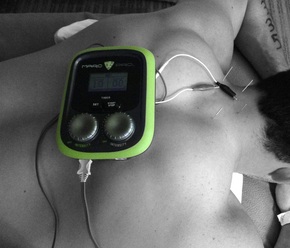4 Dry Needling Questions Answered
Jun 16, 2014
When I bring up the technique of Performance Dry Needling with my clients in the Atlanta area I get a few common reactions. They either cringe, immediately start to sweat or nervously ask what I'm talking about. All of these reactions will depend on your fear level with needles or if you have ever had dry needling techniques performed on you in the past. I’m going to give my most simple summary of the technique and how it works. I also want to make one bold statement. The technique of Performance Dry Needling is hands down the most effective treatment option we have at Athletes’ Potential! Hopefully after reading this article you will have a better understanding of why we like it so much and what you can expect.
Is Dry Needling The Same As Acupuncture?
Absolutely not! I am not an acupuncturist. I am a physical therapist with advanced training in the technique of dry needling and developed my own variation of the technique called Performance Dry Needling. Acupuncture is a very old and well respected practice that targets meridian lines in the body. The intent of acupuncture is to restore balance in the body by targeting specific points that match up with the meridian lines. This treatment could be for musculoskeletal pain or even internal sickness such as gut irritation. I have had many clients get great results with chronic pain issues when going in for acupuncture treatment. One of the only similarities that dry needling has with acupuncture is the actual needles that are used in the technique.
Dry needling is much more of an anatomical approach, meaning we focus on treating specific muscles, tendons, ligaments or nerves. There are also specific areas in the muscles that tighten up called trigger points. This can happen for a number of reasons but we know that treating these areas with dry needling is very effective. I don’t know much about chi and meridian lines. I do know a lot about the anatomy of the human body and that is what guides the choice for where to perform dry needling.
How Did Performance Dry Needling Come About?
Performance Dry Needling started with my work with the 25th Infantry Division Best Ranger Competition Teams as well as CrossFit 808’s Competition Team. I wanted to see if I could use the dry needling techniques that I had been using successfully with my clients that were injured and transition those techniques to a competitive group. Both of these groups of athletes put in huge volumes of training and push their bodies to the limit. With high volumes of training comes increased risk for injury. Performance Dry Needling was the solution to help with increased recovery and to help these athletes maintain better movement during their competitions. By targeting specific muscles, tendons and ligaments with needles and the Marc Pro Recovery Unit, we were able to dramatically increase recovery. Recover faster, train harder and win more often!
Does Dry Needling Hurt?
Simply put yes it's uncomfortable but so does laying on a lacrosse ball for a few minutes! Everyone tolerates this technique differently depending on their fear of needles, pain tolerance and severity of injury. The technique is made as painless as possible but soreness can linger for 1-2 days after the treatment. You can also expect significant changes in mobility, decrease in pain and increase in performance after the treatment.
Where Does Dry Needling Work The Best?
In my experience dry needling has the greatest effect on the spine. This is the one area I treat the most no matter if your pain is in your actual spine or your knee. Our body often refers pain to our arms and legs from issues starting at the spine. Think of Performance Dry Needling to the spine as a reset to the muscles that are treated. If you have a problem with your computer what tends to fix it, the restart! We can help get muscles functioning better around the spine which has a significant effect on your overall performance.
More Information
If you want to know some of the more advanced physiology of why dry needling works so well please read Sue Falsone’s recent article. She’s a phenomenal physical therapist and recently started teaching her own variation of dry needling call Systemic Dry Needling. Can't wait to go to one of her seminars and learn some new techniques!
Have you had any type of dry needling treatment before? If so share your experience, I'd love to hear your response to the treatment in the comments below.
-Dr. Danny, PT, DPT
Let us help you figure out to live your best active life today!
Remember, Movement is Medicine!

